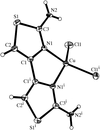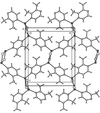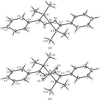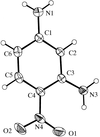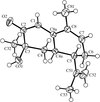issue contents
April 2001 issue

Cover illustration: Packing diagram of ammonium 2,4-dinitro-1-naphthalenolate viewed along [100]. See Yatsenko, Paseshnichenko, Chernyshev & Schenk [Acta Cryst. (2001), C57, 397-399].
inorganic compounds
Download citation


Download citation


The structure of CaMn2O4, the parent compound in this structure class, has been redetermined. Octahedrally coordinated manganese(III) metal centers show expected Jahn–Teller distortions, and form edge-sharing dimers which pack in a herring-bone arrangement.
Download citation


Download citation


Lithium manganese oxide crystals with composition (Li0.91Mn0.09)Mn2O4 were synthesized by a flux method. The crystals have a structure closely related to that of the cubic spinel LiMn2O4, but 9% of the lithium ions in the tetrahedral 4a site are substituted by Mn2+ ions. This substitution lowers the average Mn oxidation state below 3.5+, resulting in a Jahn–Teller distortion of the MnO6 octahedron.
Download citation


Download citation


The structure of RbCu2VS4 is comprised of [Cu2VS4]− layers within the (010) plane which are separated by Rb+ cations. The layers consist of a network of edge- and corner-sharing [VS4] and [CuS4] tetrahedra parallel to (010). The optical gap was determined as 1.45 eV.
Download citation


Download citation


Rubidium molybdenum selenide crystallizes in the trigonal space group R . Its crystal structure consists of a mixture of Mo12Se14Se6 and Mo15Se17Se6 cluster units in a 1:2 ratio. Both units are interconnected through Mo—Se bonds. The Rb+ cations occupy large voids between the different cluster units.
. Its crystal structure consists of a mixture of Mo12Se14Se6 and Mo15Se17Se6 cluster units in a 1:2 ratio. Both units are interconnected through Mo—Se bonds. The Rb+ cations occupy large voids between the different cluster units.
Download citation


Download citation


Sr3ZnPtO6 and Sr3CdPtO6 crystals were grown from a KOH flux. The isostructural compounds adopt the rhombohedral K4CdCl6 structure type, featuring chains of face-shared ZnO6 or CdO6 trigonal prisms alternating with PtO6 octahedra along [001]. The metal–oxygen polyhedral chains are separated by Sr2+ cations.
Download citation


Download citation


The crystal structure of Ba3(AlO4)H is isotypic with Ba3SiS5 and contains AlO45− and H− anions. The hydride and oxide anions are coordinated by six Ba and five Ba/one Al atoms in an octahedral geometry. The hydrogen content was examined by MAS–NMR experiments of the deuterated compound.
Download citation


Download citation


The title compound takes the YBCO-type structure [x = 0.74 (4)]. A careful structure analysis showed no atom mixing of the Sm atom at the Ba site and significant deficiency of oxygen content at the basal plane of the CuO6 octahedron.
Download citation


Download citation


The structure of the title compound, consisting of two double crankshaft chains of disordered [(Si,Ge)O4] tetrahedra connected at right angles to each other and forming a framework, has been determined using a synchrotron X-ray source.
Download citation


Download citation


The title compound is composed of corner-linked ZnN4/2 tetrahedra. Carbon and nitrogen form (CN2)2− dumb-bells with the C atom on a two fold axis. Nitrogen is approximately trigonally planar coordinated by two Zn atoms and one C atom.
metal-organic compounds
Download citation


Download citation


Download citation


Download citation


Download citation


Download citation


Download citation


Download citation


Download citation


Download citation


Download citation


Download citation


Download citation


Download citation


Download citation


Download citation


Download citation


Download citation


Download citation


Download citation


Download citation


Download citation


Download citation


Download citation


Download citation


Download citation


Download citation


Download citation


Download citation


Download citation


Download citation


Download citation


Download citation


Download citation


Download citation


Download citation


Download citation


Download citation


Download citation


Download citation


Download citation


Download citation


Download citation


Download citation


Download citation


Download citation


organic compounds
Download citation


Download citation


Download citation


Download citation


Download citation


Download citation


Download citation


Download citation


Download citation


Download citation


Download citation


Download citation


Download citation


Download citation


Download citation


Download citation


Download citation


Download citation


Download citation


Download citation


Download citation


Download citation


Download citation


Download citation


Download citation


Download citation


Download citation


Download citation


Download citation


Download citation


Download citation


Download citation


Download citation


Download citation


Download citation


Download citation


Download citation


Download citation


Download citation


Download citation


Download citation


Download citation


Download citation


Download citation


Download citation


Download citation


Download citation


Download citation


Download citation


Download citation


Download citation


Download citation


Download citation


Download citation


Download citation


Download citation


Download citation


Download citation


Download citation


Download citation


Download citation


Download citation


Download citation


Download citation


addenda and errata
Download citation


Download citation


Free 

Download citation


Download citation


Free 



 journal menu
journal menu






















